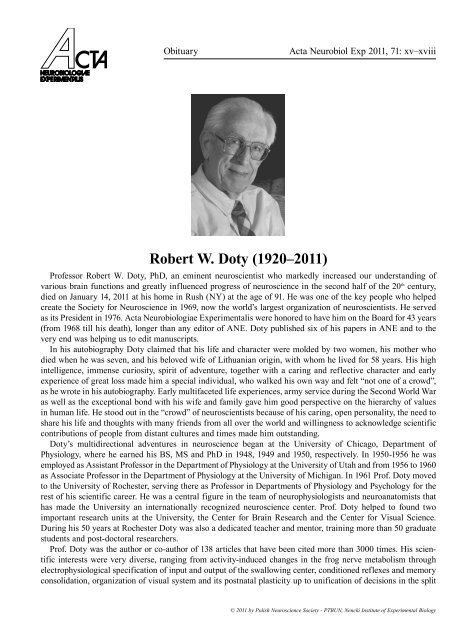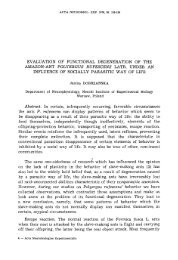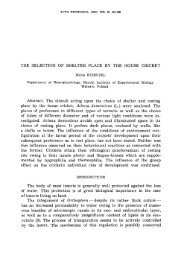Robert W. Doty (1920–2011) - Acta Neurobiologiae Experimentalis
Robert W. Doty (1920–2011) - Acta Neurobiologiae Experimentalis
Robert W. Doty (1920–2011) - Acta Neurobiologiae Experimentalis
Create successful ePaper yourself
Turn your PDF publications into a flip-book with our unique Google optimized e-Paper software.
Obituary<br />
<strong>Acta</strong> Neurobiol Exp 2011, 71: xv–xviii<br />
<strong>Robert</strong> W. <strong>Doty</strong> (<strong>1920–2011</strong>)<br />
Professor <strong>Robert</strong> W. <strong>Doty</strong>, PhD, an eminent neuroscientist who markedly increased our understanding of<br />
various brain functions and greatly influenced progress of neuroscience in the second half of the 20 th century,<br />
died on January 14, 2011 at his home in Rush (NY) at the age of 91. He was one of the key people who helped<br />
create the Society for Neuroscience in 1969, now the world’s largest organization of neuroscientists. He served<br />
as its President in 1976. <strong>Acta</strong> <strong>Neurobiologiae</strong> <strong>Experimentalis</strong> were honored to have him on the Board for 43 years<br />
(from 1968 till his death), longer than any editor of ANE. <strong>Doty</strong> published six of his papers in ANE and to the<br />
very end was helping us to edit manuscripts.<br />
In his autobiography <strong>Doty</strong> claimed that his life and character were molded by two women, his mother who<br />
died when he was seven, and his beloved wife of Lithuanian origin, with whom he lived for 58 years. His high<br />
intelligence, immense curiosity, spirit of adventure, together with a caring and reflective character and early<br />
experience of great loss made him a special individual, who walked his own way and felt “not one of a crowd”,<br />
as he wrote in his autobiography. Early multifaceted life experiences, army service during the Second World War<br />
as well as the exceptional bond with his wife and family gave him good perspective on the hierarchy of values<br />
in human life. He stood out in the “crowd” of neuroscientists because of his caring, open personality, the need to<br />
share his life and thoughts with many friends from all over the world and willingness to acknowledge scientific<br />
contributions of people from distant cultures and times made him outstanding.<br />
<strong>Doty</strong>’s multidirectional adventures in neuroscience began at the University of Chicago, Department of<br />
Physiology, where he earned his BS, MS and PhD in 1948, 1949 and 1950, respectively. In 1950-1956 he was<br />
employed as Assistant Professor in the Department of Physiology at the University of Utah and from 1956 to 1960<br />
as Associate Professor in the Department of Physiology at the University of Michigan. In 1961 Prof. <strong>Doty</strong> moved<br />
to the University of Rochester, serving there as Professor in Departments of Physiology and Psychology for the<br />
rest of his scientific career. He was a central figure in the team of neurophysiologists and neuroanatomists that<br />
has made the University an internationally recognized neuroscience center. Prof. <strong>Doty</strong> helped to found two<br />
important research units at the University, the Center for Brain Research and the Center for Visual Science.<br />
During his 50 years at Rochester <strong>Doty</strong> was also a dedicated teacher and mentor, training more than 50 graduate<br />
students and post-doctoral researchers.<br />
Prof. <strong>Doty</strong> was the author or co-author of 138 articles that have been cited more than 3000 times. His scientific<br />
interests were very diverse, ranging from activity-induced changes in the frog nerve metabolism through<br />
electrophysiological specification of input and output of the swallowing center, conditioned reflexes and memory<br />
consolidation, organization of visual system and its postnatal plasticity up to unification of decisions in the split<br />
© 2011 by Polish Neuroscience Society - PTBUN, Nencki Institute of Experimental Biology
xvi Obituary – R.W. <strong>Doty</strong><br />
brain of macaques. His team discovered very unusual brain neurons, known as luxotonic cells that are sensitive<br />
to a wide range of light levels, from near darkness to extreme brightness. Recently, scientists have taken a renewed<br />
interest in these cells and a previously unknown brain circuit has been discovered that is involved in regulating<br />
the eye’s pupil size and the body’s circadian rhythm. Long-time collaboration of Prof. <strong>Doty</strong> with Prof Żernicki<br />
from the Nencki Institute concerned investigation of the interplay of midbrain and cortex in maintaining the state<br />
of consciousness (1970) and of the interhemispheric transfer of information required for habituation (1997). Later,<br />
Nencki post-docs had the great opportunity to expand their knowledge and skills in his laboratory.<br />
Prof. <strong>Doty</strong> was one of the key people in the team that in 1969 created the Society for Neuroscience that now<br />
has more than 40,000 members and in 1975-1976 he served as its president. He participated in almost all yearly<br />
Meetings of the Society, always driving there by car. Prof. <strong>Doty</strong> was also a fellow of the American Physiological<br />
Association, the American Psychological Association, the American Association for the Advancement of<br />
Science, International Brain Research Organization, American Society of Primatologists, the American Society<br />
for Advancement of Science and the Japan Society for Promotion of Science. He served also as a visiting professor<br />
at the University of Mexico and Osaka University in Japan.<br />
In 1996 <strong>Doty</strong> retired, continuing as part-time Professor Emeritus in the Department of Neurobiology and<br />
Anatomy, University of Rochester Medical Center. He was very devoted to his research and kept his laboratory<br />
going long after retirement, frequently buying equipment and supplies with his own money. He also donated<br />
funds and guidance to create an annual lectureship on “Consciousness from neurons” in the name of his wife,<br />
Elizabeth Jusewich-<strong>Doty</strong>, who died in 1999. To honor her memory and their marriage, he also compiled, wrote<br />
and self-published a book “Man and woman, war and peace, 1941-1951: A dual autobiography verbatim from<br />
their letters and diary” based on letters they had exchanged during his World War II Army service and Elizabeth’s<br />
detailed diary which she kept throughout their married life.<br />
Throughout his career Prof <strong>Doty</strong> frequently acknowledged contributions of thinkers and scientists that were<br />
first to propose various scientific ideas, like Alkmaion, who first put forward the idea that our thoughts are a<br />
functioning of the brain, and of neuroscientists from Eastern Europe, like Pavlov, Bekhterev, Beritashvili or<br />
Konorski whose contributions are frequently overlooked. With accumulating scientific experience, <strong>Doty</strong> was<br />
also reflecting on the inadequacy of our ideas describing immensely complex brain phenomena. Results of his<br />
experiments of conditioning with paired electrical stimulation of different parts of the cerebral cortex, which<br />
drew on Pavlov’s and his pupil Pyotr Kupalov’s ideas and were conducted with another Pavlov’s pupil, Cornel<br />
Giurgea, led him to formulate broader ideas about reality of our cognition of the world and internal production<br />
of brain images (“butterflies in the brain”). Results of <strong>Doty</strong>’s experiments are helping now in building prostheses<br />
of the visual system and his reflections on these results help bridge neuroscience and philosophy.<br />
In spite of his own and his family’s health problems in the last years, Prof. <strong>Doty</strong> maintained curiousity,<br />
thoughtfulness and a positive attitude to the very end of his life. He is survived by his four children and two<br />
great-grandchildren and predeceased by his wife and granddaughter. His body was donated to the Anatomical<br />
Gift Program at the University of Rochester Medical Center. Thus, there was no funeral service in January 2011,<br />
but a memorial service was held on June 26, 2011. Many people all over the world will remember him and are<br />
going to miss the yearly “<strong>Doty</strong> Doings”, fascinating accounts of his experiences and thinking that he had been<br />
sending faithfully to friends all over the world.<br />
Selected bibliography of Prof. <strong>Robert</strong> W. <strong>Doty</strong><br />
Anna Nowicka<br />
Kris Turlejski<br />
Anonymous. Fifth army at the winter line (15 November 1943-15 January 1944) (1945) Washington, DC: Historical<br />
Division, U.S. War Department, U.S. Government Printing Office, Superintendent of Documents.<br />
<strong>Doty</strong> RW, Gerard RW (1950) Nerve conduction without increased oxygen consumption: Action of azide and fluoroacetate.<br />
Am J Physiol 162: 458–468.
Polish Neuroscience Society Chronicle xvii<br />
<strong>Doty</strong> RW (1951) Influence of stimulus pattern on reflex deglutition. Am J Physiol 166: 142–158.<br />
<strong>Doty</strong> RW, Rutledge LT Jr, Larsen RM (1956) Conditioned reflexes established to electrical stimulation of cat cerebral cortex.<br />
J Neurophysiol 19: 401–415.<br />
<strong>Doty</strong> RW, Bosma JF (1956) An electromyographic analysis of reflex deglutition. J Neurophysiol 19: 44–60.<br />
Beck EC, <strong>Doty</strong> RW (1957) Conditioned flexion reflexes acquired during combined catalepsy and deeferentation. J Comp<br />
Physiol Psychol 50: 211–216.<br />
<strong>Doty</strong> RW (1958) Potentials evoked in cat cerebral cortex by diffuse and by punctiform photic stimuli. J Neurophysiol<br />
21: 437–464.<br />
<strong>Doty</strong> RW (1961) Functional significance of the topographical aspects of the retinocortical projection. In: The visual system:<br />
neurophysiology and psychophysics (Jung R, Kornhuber H, eds.). Springer-Verlag, Heidelberg, p. 228–245.<br />
<strong>Doty</strong> RW, Giurgea C (1961) Conditioned reflexes established by coupling electrical excitation of two cortical areas. In:<br />
Brain mechanisms and learning (Fessard A, Gerard RW, Konorski J, Delafresnaye JF, eds.). Blackwell, Oxford,<br />
p. 133–151.<br />
<strong>Doty</strong> RW, Grimm FR (1962) Cortical responses to local electrical stimulation of retina. Exp Neurol 5: 319–334.<br />
<strong>Doty</strong> RW, Kimura DS (1963) Oscillatory potentials in the visual system of cats and monkeys. J Physiol (London)<br />
168: 205–218.<br />
<strong>Doty</strong> RW, Kimura DS, Mogenson GJ (1964) Photically and electrically elicited responses in the central visual system of the<br />
squirrel monkey. Exp Neurol 10: 19–51.<br />
<strong>Doty</strong> RW (1965) Philosophy and the brain. Perspectives Biol Med 9: 23–34.<br />
<strong>Doty</strong> RW, Richmond WH, Storey AT (1967) Effect of medullary lesions on coordination of deglutition. Exp Neurol<br />
17: 91–106.<br />
<strong>Doty</strong> RW (1968) Neural organization of deglutition. In: Handbook of physiology. Section 6: Alimentary canal, vol. IV,<br />
Motility (Code CF, ed.). American Physiological Society, Washington, DC, p. 1861-1902.<br />
Kesner RP, <strong>Doty</strong> RW (1968) Amnesia produced in cats by local seizure activity initiated from the amygdala. Exp Neurol<br />
21: 56–68.<br />
<strong>Doty</strong> RW (1970) On butterflies in the brain. In: Electrophysiology of the central nervous system (Rusinov VS, ed.; B Haigh,<br />
trans; RW <strong>Doty</strong>, trans ed). Plenum, New York, NY, p. 97–106.<br />
Kesner RP, McDonough JJ Jr, <strong>Doty</strong> RW (1970) Diminished amnestic effect of a second electroconvulsive seizure. Exp<br />
Neurol 27: 527–533.<br />
Zernicki B, <strong>Doty</strong> RW, Santibañez G (1970) Isolated midbrain in cats. Electroencephalogr Clin Neurophysiol 28: 221–235.<br />
<strong>Doty</strong> RW (1971) Survival of pattern vision after removal of striate cortex in the adult cat. J Comp Neurol 143: 341–370.<br />
<strong>Doty</strong> RW (1973) Ablation of visual areas in the central nervous system. In: Handbook of sensory physiology, Vol. VH/SB<br />
(Jung R, ed.). Springer-Verlag, Berlin, p. 483–541.<br />
Bartlett JR, <strong>Doty</strong> RW, Pecci-Saavedra J, Wilson PD (1973) Mesencephalic control of lateral geniculate nucleus in primates.<br />
III. Modifications with state of alertness. Exp Brain Res 18: 214–224.<br />
<strong>Doty</strong> RW, Negrao N (1973) Forebrain commissures and vision. In: Handbook of sensory physiology: Central processing of<br />
visual information. Part B. VII/3B (Jung R, ed.). Springer-Verlag, Berlin, p. 543–582.<br />
<strong>Doty</strong> RW, Negrao N, Yamaga K (1973) The unilateral engram. <strong>Acta</strong> Neurobiol Exp (Wars) 33: 711–728.<br />
<strong>Doty</strong> RW (1976a) The concept of neural centers. In: Simpler networks and behavior (Fentress J, ed.). Sinaure, Sunderland,<br />
MA, p. 251–265.<br />
<strong>Doty</strong> RW (1976b) Consciousness from neurons. <strong>Acta</strong> Neurobiol Exp (Wars) 35: 791–804.<br />
Bartlett JR, <strong>Doty</strong> RW, Lee BB, Sakakura H (1976) Influence of saccadic eye movements on geniculostriate excitability in<br />
normal monkeys. Exp Brain Res 25: 487–509.<br />
Sakakura H, <strong>Doty</strong> RW (1976) EEG of striate cortex in blind monkeys: effects of eye movements and sleep. Arch Ital Biol<br />
114: 23–48.<br />
Kayama Y, Riso RR, Bartlett JR, <strong>Doty</strong> RW (1979) Luxotonic responses of units in macaque striate cortex. J Neurophysiol<br />
42: 1495–1517.<br />
Bartlett JR, <strong>Doty</strong> RW (1980) An exploration of the ability of macaques to detect microstimulation of striate cortex. <strong>Acta</strong><br />
Neurobiol Exp (War) 40: 713–728.
xviii Obituary – R.W. <strong>Doty</strong><br />
<strong>Doty</strong> RW, Bartlett JR (1981) Stimulation of the brain with metallic electrodes. In: Electrical stimulation research techniques<br />
(Patterson MM, Kesner RP, eds.). Academic Press, New York, NY, p. 71–103.<br />
<strong>Doty</strong> RW (1983) Nongeniculate afferents to striate cortex in macaques. J Comp Neurol 218: 159–173.<br />
Bolanowski SJ Jr, <strong>Doty</strong> RW (1987) Perceptual “blankout” of monocular homogeneous fields (Ganzfelder) is prevented with<br />
binocular viewing. Vision Res 27: 967–982.<br />
<strong>Doty</strong> RW, Ringo JL, Lewine JD (1988) Forebrain commissures and visual memory: A new approach. Behav Brain Res<br />
29: 267–280.<br />
<strong>Doty</strong> RW (1989) Schizophrenia: a disease of interhemispheric processes at forebrain and brainstem levels? Behav Brain Res<br />
34: 1–33.<br />
<strong>Doty</strong> RW (1990) Forebrain commissures and the unity of mind. In: Machinery of the mind (John ER, ed.). Birkhauser,<br />
Boston, MA, p. 3–13.<br />
Lewine JD, <strong>Doty</strong> RW, Astur RS, Provencal SL (1994) Role of the forebrain commissures in bihemispheric mnemonic integration<br />
in macaques. J Neurosci 14: 2515–2530.<br />
Ringo JL, <strong>Doty</strong> RW, Demeter S, Simard PY (1994) Time is of the essence: A conjecture that hemispheric specialization<br />
arises from interhemispheric conduction delay. Cerebral Cortex 4: 331–343.<br />
<strong>Doty</strong> RW (1995) Brainstem influences on forebrain processes, including memory. In: Neurobehavioral plasticity: learning,<br />
development, and response to brain insults (Spear NE, Spear LP, Woodruff ML, eds.). Erlbaum, Hillsdale, NJ,<br />
p. 349-370.<br />
Zernicki B, Stasiak M, <strong>Doty</strong> RW (1997) Habituation of ocular following reflex requires corpus callosum for interhemispheric<br />
transfer. Behav Brain Res 84: 269–274.<br />
<strong>Doty</strong> RW (1998) The five mysteries of the mind, and their consequences. Neuropsychologia 36: 1069–1076.<br />
<strong>Doty</strong> RW, Fei R, Hu S, Kavcic V (1999) Long-term reversal of hemispheric specialization for visual memory in a split-brain<br />
macaque. Behav Brain Res 102: 99–113.<br />
<strong>Doty</strong> RW (2000) Interhemispheric abnormalities in schizophrenia and their possible etiology. In: The role of the corpus callosum<br />
in sensorimotor integration (lacoboni M, Zaidel E, eds.). MIT Press, Cambridge, MA, p. 445–452.<br />
Kavcic V, Fei R, Hu S, <strong>Doty</strong> RW (2000) Hemispheric interaction, metacontrol, and mnemonic processing in split-brain<br />
macaques. Behav Brain Res 111: 71–82.<br />
Kavcic V, <strong>Doty</strong> RW (2002) Efficiency of the forebrain commissures: memory for stimuli seen by the other hemisphere. <strong>Acta</strong><br />
Neurobiol Exp (Wars) 62: 235–142.<br />
<strong>Doty</strong> RW (2003) Unity from duality. <strong>Acta</strong> Neurobiol Exp (Wars) 63: 163–170.<br />
DeYoe EA, Lewine JD, <strong>Doty</strong> RW (2005) Laminar variation in threshold for detection of electrical excitation of striate cortex<br />
by macaques. J Neurophysiol 94: 3443–3450.<br />
Bartlett JR, DeYoe EA, <strong>Doty</strong> RW, Lee BB, Lewine JD, Negrão N, Overman WH Jr (2005) Psychophysics of electrical<br />
stimulation of striate cortex in macaques. J Neurophysiol 94: 3430–3442.<br />
<strong>Doty</strong> RW (2006) Konorski and conditional reflexes: a historical summary and an addendum. <strong>Acta</strong> Neurobiol Exp (Wars)<br />
66: 91–95; discussion 95–97.<br />
<strong>Doty</strong> RW (2007) Alkmaion’s discovery that brain creates mind: a revolution in human knowledge comparable to that of<br />
Copernicus and of Darwin. Neuroscience 147: 561-568.<br />
Tsagareli MG, <strong>Doty</strong> RW (2009) Ivane S. Beritashvili (1884-1974): from spinal cord reflexes to image-driven behavior.<br />
Neuroscience 163: 848–856.









